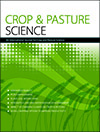Green gram (Vigna radiata) is an important source of plant-based dietary protein. Green gram seeds exhibit variable proportion of hard seeds that do not imbibe water; known as ‘physical dormancy’ or ‘hardseededness’. Seed hardness leads to extended cooking time to allow softening to a desired texture. A relatively low lignin, calcium, phenol, and structural carbohydrate content in varieties grown in summer seasons may be the reason behind lower occurrence of hard seeds.

Crop & Pasture Science
Volume 76 Number 1 2025
We compared the flowering patterns of wild and cultivated carrot genotypes in the context of quality carrot seed production. Wild carrots exhibited higher overwintering survival, thrive in different environmental conditions, have a more flexible life history approach, and attract reward pollinators better than cultivated carrots. Our findings provide baseline information for policymakers, scientists, industrialists, and growers to control wild carrots and produce genetically pure commercial seeds by incorporating knowledge of lifecycles and flowering behaviour of wild and cultivated carrots.
CP24320 Abstract | CP24320 Full Text | CP24320PDF (1.6 MB) Open Access Article
Chickpea (Cicer arietinum) is grown in arid climate of the southern Punjab in Pakistan. The major limits on chickpea production are poor genetic diversity, low and variable yield, and vulnerability to biotic and abiotic stressors. However, the abundance of chickpea germplasm accessions provides opportunity for improved production in a range of biotic and abiotic constraints.
This article belongs to the collection: Plant breeding- and genetics-based tools for food security under changing climate.
There are various methods available for the calculation of critical soil test values. We provide a new method that overcomes the shortcomings of previous approaches and provides a result for critical soil test value that is intermediate to the conventional Mitscherlich and the arcsine-log calibration curve (ALCC) methods. We recommend that this new proposed method be applied to a broad range of soil test data sets in order to establish its utility as the preferred method.
CP24162 Abstract | CP24162 Full Text | CP24162PDF (1.1 MB) Open Access Article




